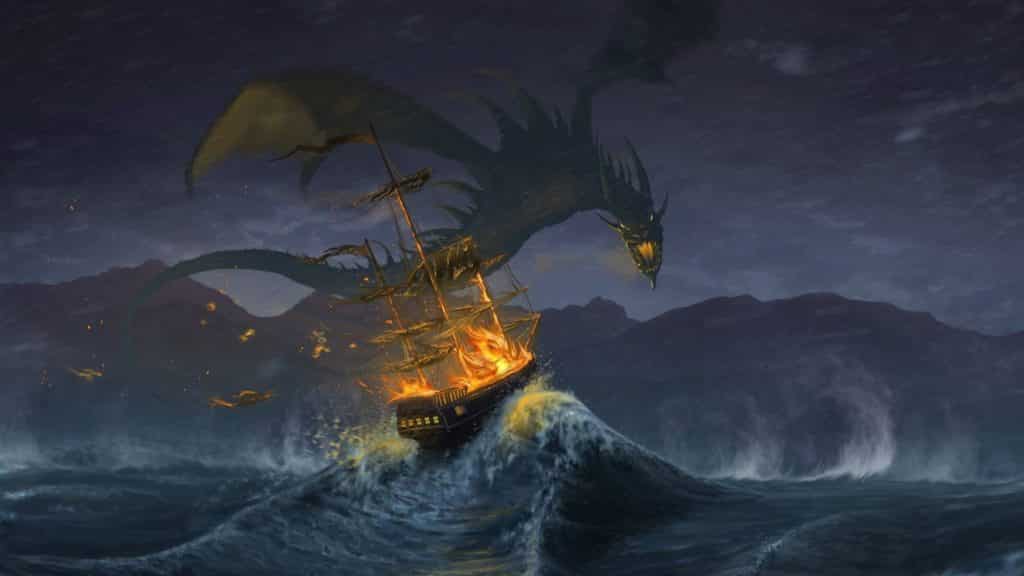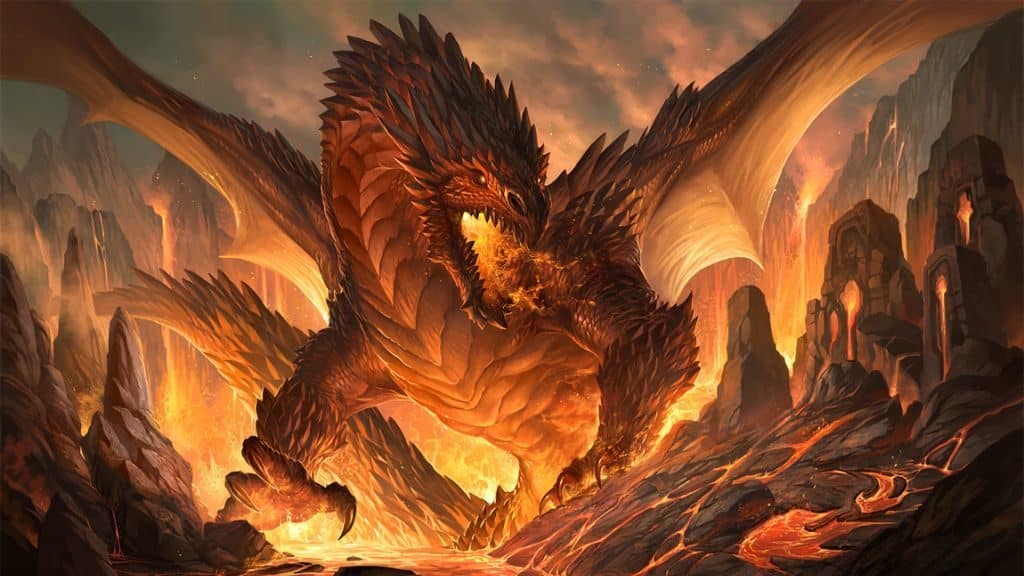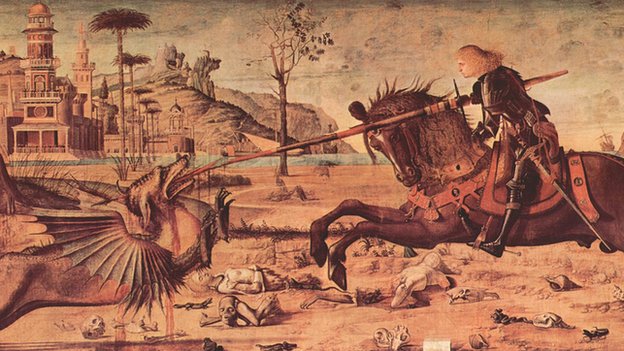Dragons are magnificent creatures and mighty beasts. Western dragons perhaps more than any others. They’re the stuff of many of those dragon legends that you love.
You already knew that! But did you know dragons aren’t all the same? Tons of people have this built-in image of dragons that pop up whenever they’re mentioned, it’s usually of enormous monsters, flying around and breathing fire. While that’s not totally off, it’s actually based on a portrait of western dragons.
Western dragons are one of the most famous types of dragons. We want to get into detail about their history, traits, and how they differ from their counterparts the eastern dragons.
Western Dragons Across History
Looking through written and recorded history, we find dragons woven throughout. From ancient myths and legends to songs, folk tales and stories, dragons are a constant presence.
The English word “dragon” originates from the Greek word “dragon” meaning serpent. This is where we can see the reptile heritage come to life. The term, western dragons, is genrally used to describe dragons from European countries, seeing as they share cultural similarities.
Traditionally, western dragons were symbolized as evil maleficent beings. They’re often seen as soldiers of wrongdoing, guarding towers with imprisoned princesses, raiding innocent towns, hoarding heaps of gold and treasures as the greedy vile monsters they are. These dragons are meant to be confronted and slayed as an ultimate sign of bravery facing the dark side of violence.
In Greek mythology, dragons appear multiple times defeated by Gods and demigods. Zeus defeated Typhon using a thunderbolt, his son, Apollo, killed Python using a bow and an arrow at the young age of four years. Hercules slew Ladon, a dragon with one hundred heads of snakes, and also overtook Lernaean Hydra, the water serpent dragon with an immortal head.
Dragons also appear in British, French, Babylonian, and Ukrainian legends and folk. Even Vikings have a history involving dragons in their warships to fend off sea monsters and evil spirits.
However, as interest grew in dragon-related fantasy genre games, series, and movies, the view on dragons started to change to a more positive one. While still regarded as powerful as ever, they are portrayed more as protectors and allies that are sometimes misunderstood.
On the flip side, eastern dragons, also known as Chinese dragons, are considered to be wise noble creatures, glorified to be respected and followed.
They represent peace, prosperity, and authority. You can see them heavily incorporated in Chinese folklore and art, with shrines and temples in their honor.
Oriental dragons are believed to control the weather, summoning rain and wind as they please. In Chinese mythology, many types of dragons exist with specific qualities, the oldest most famous one being Yinglong, which is also the only one with wings.
Appearance of Western Dragons
You may already have looked at our study into the anatomy of dragons, but how do western dragons shape up?
Well, they’re generally huge in size. They possess six limbs – four legs and two wings. Given all of this, you can see why it’s hard to classify them among other vertebrates, which are tetrapods.
These dragons have large heads, long necks, wide shoulders, thick legs, tough tails, and of course distinct gigantic bat-like wings. Their jaws are big with razor-sharp teeth. Western dragons are reptilian lizard-like animals with scales covering their bodies and pointy horns on their heads.
Chinese dragons are a tiny bit smaller, their bodies are very long like those of snakes without wings. They don’t fly, it’s more that they magically hover. They also have four legs.
In Chinese legend, dragons are said to resemble nine animals. The most prominent are antlers of a deer, scales of a carp, claws of an eagle, soles of a tiger, and eyes of a demon
Skeleton
The bone structure of western dragons is immensely strong and solid. Their skulls are huge, followed by many vertebrae comprising the neck, broad shoulders, and sizeable legs. The wing is similar to basic arm anatomy, which consists of two main bones. However, the “fingers” are very long ending with pointed claws. It’s crucial to note that while the bones are tough, they’re hollow so as to be light enough to enable flight.
Eastern dragons, on the other hand, have extremely lengthy yet narrower skeletons. They have medium-sized heads, shorter legs and longer necks that go on to form the body. Their bones are strong but not hollow, as they don’t require strength or force to fly, it’s all magic. As we said earlier, they don’t carry wings, which is a major difference between the two types of dragons.
External Body and Colors
Dragons bodies are rugged and rough, covered completely in scales, except for a few soft parts like the belly and the neck. Scales are groups of densely packed cells made of a fibrous protein called keratin. If you’re not familiar with keratin, it’s the substance that makes up skin, horns, hair, hoofs, bills, feathers, claws and nails.
Dragons can actively peer their scales making them stand on end, but normally, scales overlap over one another with a perfectly arranged fit. They can also be used as a last resort armor.
After being hatched, baby dragons don’t show such solid scales. Actually, they’re soft as paper tissues. However, as the dragon grows, the iron from the blood or the vegetable materials eaten by the dragon gets mixed with the keratin to create scales hard as steel. It takes about one year to reach the final degree of toughness.
Colors of dragons are incredibly mesmerizing, typically a beautiful gradient of a certain color, rather than one uniform solid color. While we can’t put those colors into definite words, we can sort them into three general categories; blues, reds, and greens.
Blues range from petrol blue to silver, all the way to mother-of-pearl. Copper-reds, dark blackish reds, and blood reds all fall under the red group. Greens include just about any shade of green, yellow, and even brown. A dragon’s color is usually of a metallic luster and is determined according to the parent’s genes. Vibrant shiny scales indicate good health, while blunt muted ones are a sign of illness.
How do Western Dragons Fly?
Unlike eastern dragons, which use some kind of earth-magic, western dragons actually work for it.
Their webbed and leathery wings are understandably enormous. After all, they have to accommodate and support the matching huge bodies. They are also supported at four different points, to further withstand weight and force. The fact that their bones are hollow really supports their flight action.
The up and down motion of a scooping style allows the wing to entrap air, thrusting the dragon upward. As the wings are connected to the body close to the thighs, the weight of the dragon’s neck and the tail is equally distributed which gives balance and easy altitude control.
An immature dragon doesn’t have the strength to maintain a continuous sweep of the wings, and so, it takes off using a high-level ground such as a cliff.
Senses
Dragons share the same five fundamental senses as humans; sight, hearing, smelling, touch, and taste. What’s special though, is how super heightened and sensitive they are. They can pick up a smell or a sound from miles away!
An additional unique sixth sense of dragons is their ability to read emotions. If another creature is experiencing a strong feeling such as anger or fear, they can register it. This works best in close proximity.
Fire Breathers
The most powerful weapon a western dragon can unleash upon its victims is the dreaded fire breath. The hellish flame that eats up flesh and burns through bones until nothing remains but ashes. Even though some dragons can alternatively breathe acid or ice, blowing fire seems to be the most popular choice.
So how do dragons do it? Well, there has been some debate over it. The most probable theory goes like this: when a dragon digests its food, it’s further reduced into hydrogen byproducts. Hydrogen is stored in several large hydrogen glands to use when the time arrives. Once ticked off, hydrogen is released into the lungs where it mixes with various chemicals, and as soon as this blend finds oxygen, it’s blazing time!
A second theory relates to digestion as well, but instead of hydrogen, methane gas is produced and stored in designated glands. To unleash fire, methane interacts with bits of phosphor, a mixture that ignites when exposed to air.
Mating and Reproduction
Finding a suitable partner is the first thing at the top of a dragon’s list when they’re ready to commit and start a family unit. Don’t be surprised, as western dragons are sensible creatures in search of stability and offspring. Males look for beautiful females capable of carrying and nourishing babies, while females want a strong dependable male able to provide and protect their family. When two dragons accept each other, the breeding gates break loose!
Western dragons adore flying. The risk and speed is something they strive for, so it’s only logical that they take their love up there. The mating process, known as the dragon slide, happens when both partners fly high into the sky, grab each other close, fold their wings, and free-fall together. They spread their wings about a hundred feet from the ground and land.
Once impregnated, the female dragon bears the eggs for a few months, then lays then as soon as the shells harden. Eggs don’t have exact incubation periods, some take a year while others take five. After they hatch, baby dragons embark on their own adventures as they begin to master their abilities.
Final Thoughts
Western dragons are such fascinating creatures. Their superior traits and powers can definitely have us talking for days. However, we hope that we’ve managed to quench a fragment of your curiosity with our bits of knowledge and theories about the mysterious world of dragons.



